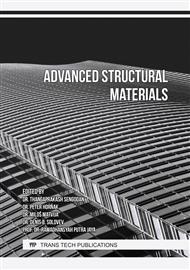[1]
Wood boards and plywood today: numbers, facts and development prospects, https://proderevo.net/industries/wooden-plates/drevesnye-plity-i-fanera-segodnya-tsifry-fakty-problemy-i-perspektivy-razvitiya.html
Google Scholar
[2]
Russian plywood industry: to keep up, you need to change, https://lesprominform.ru/jarticles.html?id=3082
Google Scholar
[3]
H.R. Mansouri, A. Pizzi Pizzi, J.-M. Leban, Improved water resistance of UF adhesives for plywood by small pMDI additions, European Journal of Wood and Wood Products. 64(3) (2006) 218–220.
DOI: 10.1007/s00107-005-0046-z
Google Scholar
[4]
D. Dukarska, R. Czarnecki, Fumed silica as a filler for MUPF resin in the process of manufacturing water-resistant plywood, European Journal of Wood and Wood Products. 74(1) (2015) 5–14.
DOI: 10.1007/s00107-015-0955-4
Google Scholar
[5]
P. Bekhta, J. Sedliačik, Environmentally-friendly high-density polyethylene-bonded plywood panels, Polymers. 11(7) (2019) 2–21.
DOI: 10.3390/polym11071166
Google Scholar
[6]
L.M. Arruda, C.D.S. Del Menezzi, Properties of a laminated wood composite produced with thermomechanically treated veneers, Advances in Materials Science and Engineering. 4 (2016) 1–9.
DOI: 10.1155/2016/8458065
Google Scholar
[7]
T. Biadała, R. Czarnecki, D. Dukarska, Water resistant plywood of increased elasticity produced from European wood species, Wood Res. 65 (2020) 111–124.
DOI: 10.37763/wr.1336-4561/65.1.111124
Google Scholar
[8]
M. Ghorbani, J. Konnerth, F. Liebner, Commercial lignosulfonates from different sulfite processes as partial phenol replacement in PF resole resins, Journal of Applied Polymer Science. 135(8) (2018) 45893–45904.
DOI: 10.1002/app.45893
Google Scholar
[9]
А.А. Fedotov, T.N. Vakhnina, S.A. Kotikov, Improving strength indicators of FSF plywood by using modifiing additives to binding agent, Forest engineering journal, 1(37) (2020) 124–135.
DOI: 10.34220/issn.2222-7962/2020.1/13
Google Scholar
[10]
T.N. Vakhnina, А.А. Fedotov, A.A. Titunin, I.V. Susoeva, Influence of modifiers on the curing time of the phenol formaldehyde binder for pressing panels at low temperature mode, Forest engineering journal, 4(36) (2019) 99–108.
DOI: 10.34220/issn.2222-7962/2019.4/11
Google Scholar
[11]
Hrazsky, P. Kral, Determination of pressing parameters of spruce water-resistance plywood, J. For. Sci. 53 (2007) 231–242.
Google Scholar
[12]
P. Bekhta, S. Hiziroglu, O. Potapova, J. Sedliacik, Shear strength of exterior plywood panels pressed at low temperature, Materials. 2(3) (2009) 876–882
DOI: 10.3390/ma2030876
Google Scholar
[13]
M. Asima, N. Saba, M. Jawaid, M. Nasirc, M. Pervaizd, O.Y. Alothman, A review on phenolic resin and its composites, Current Analytical Chemistry. 14 (2018) 1–14.
DOI: 10.2174/1573411013666171003154410
Google Scholar
[14]
J. Sedliacik, P. Bekhta, O. Potapova, Technology of low-temperature production of plywood bonded with modified phenol–formaldehyde resin, Wood research. 55(4) (2010) 124–130.
Google Scholar
[15]
М. Valyova, Y. Ivanova, Modified phenol-phormaldehyde resins used for plywood gluing, International Journal – Wood, Design & Technology. 4(1) (2015) 35–38.
Google Scholar
[16]
R. Mirski, D. Dziurka, J. Łȩcka, Potential of shortening pressing time or reducing pressing temperature for plywood resinated with PF resin modified using alcohols and esters, European Journal of Wood and Wood Products. 69(2) (2011) 317–323.
DOI: 10.1007/s00107-010-0436-8
Google Scholar
[17]
A. Yamamoto, А. Rohumaa, М. Hughes, Т. Vuorinen, L. Rautkari, Surface modification of birch veneer by peroxidebleaching, Wood Sci Technology. 51(1) (2017) 85–95.
DOI: 10.1007/s00226-016-0880-7
Google Scholar
[18]
P. Giguère, The infra‐red spectrum of hydrogen peroxide, Chemistry Journal of Chemical. 18 (1950) 88–92.
Google Scholar
[19]
B.N. Kuznetsov, I.G. Sudakova, N.V. Garyntseva, L. Djakovitch, Kinetic studies and optimization of abies wood fractionation by hydrogen peroxide under mild conditions with TiO2 catalyst, Reaction Kinetics, Mechanisms and Catalysis. 120(1) (2016).
DOI: 10.1007/s11144-016-1100-z
Google Scholar
[20]
R. Czarnecki, J. Łȩcka, H2O2 as a modifier of phenol–formaldehyde resin used in the production of particleboards, Journal of Applied Polymer Science. 88(14) (2003) 3084–3092.
DOI: 10.1002/app.11962
Google Scholar


